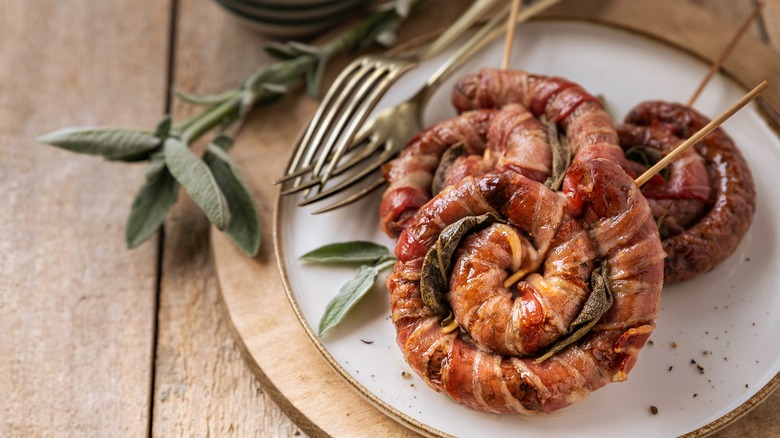The Classic Seasoning Blend You Need For Homemade Breakfast Sausage
Fans of breakfast sausage know that once you start making breakfast sausage from scratch there is no going back. The easy way is to add ingredients to your favorite store-bought sausage, like in this biscuits and herbed sausage gravy recipe that takes a package of Jimmy Dean and kicks it up with fresh herbs. The other way, the homemade way, is all about customization and the perfect blend of pork, fat, salt, and spices.
Store-bought sausage can contain more sodium than the homemade version, and there's more sugar and corn syrup, too. Some breakfast sausage connoisseurs prefer a more sweet than savory sausage, while others want varying kicks of heat. But first things first. To give your homemade breakfast sausage that essential breakfast sausage flavor, you need these essential spices, according to Hunter Shoults, the plant manager at Bear Creek Smokehouse, in charge of production of all meats. [He's the son of Robbie Shoults, celebrity chef and third-generation owner of Bear Creek Smokehouse, as well as Marshall Mercantile and High Horse 1898.]
"Sage, red pepper, black pepper, and salt are the most common ingredients included in a breakfast sausage seasoning," Shoults says. Sounds straightforward, but sage is a complex herb. It's potent and works magically in stuffings and rich meats but a little sage goes a long way. Knowing when to use it is key.
Use fresh, rubbed, or dried sage in all of your breakfast sausage recipes
While it may be tempting to flavor your homemade breakfast sausage with all sorts of yummy spice combinations, keep this in mind: It's breakfast sausage. You'll use it to make dishes like the iconic cheesy sausage breakfast casserole, or you may combine them to make a savory appetizer like this polenta and sausage stuffed mushrooms. Breakfast sausage is versatile because its salt and two-peppery notes allow the earthy notes of sage to shine. Sage is potent — like rosemary — and cooking it softens its sharpness. So add it at the end of any dish you're cooking to amplify it, or add it before cooking to tame it. With homemade breakfast sausage, the sage goes in at the beginning, so the real choice here comes down to fresh or dried.
There are two types of dried sage: Rubbed (dry, fluffy bits) or ground (powdered). Of the two, rubbed sage is less concentrated in flavor than ground. Fresh sage and rubbed sage offer a visual aspect to your sausage, which can be fun. Use a teaspoon of fresh, chopped sage or rubbed sage for every pound of pork. For dried sage, 1/2 a teaspoon per pound of ground pork will do the trick, but recipes vary and some call for up to 2 tablespoons per pound of pork. Thyme, garlic, parsley, and oregano also pair wonderfully with sage, as well as rosemary, ginger, and cumin.

